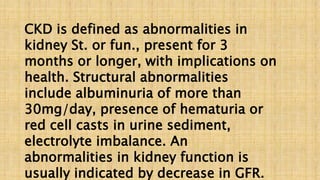CHRONIC KIDNEY DISEASE (CKD) for medical students.pptx
- 1. CHRONIC KIDNEY DISEASE (CKD) DANISH YOUSUF M PHARMA (PHARMACY PRACTICE)
- 2. CKD is defined as abnormalities in kidney St. or fun., present for 3 months or longer, with implications on health. Structural abnormalities include albuminuria of more than 30mg/day, presence of hematuria or red cell casts in urine sediment, electrolyte imbalance. An abnormalities in kidney function is usually indicated by decrease in GFR.
- 3. KDIGO CATEGORY GFR (ml/min/1.73m* 2) TERMS CORRESPONDING KDOQI CATEGORY G1 >90 NORMAL OR HIGH STAGE 1 CKD G2 60-89 MILDLY DECREASED STAGE 2 CKD G3a 45-59 MILDLY ŌĆō MODERATELY DECREASED STAGE 3 CKD G3b 30-44 MODERATELY ŌĆō SEVERLY DECREASED STAGE 3 CKD G4 15-29 SEVERLY DECREASED STAGE 4 CKD G5 <15 KIDNEY FAILURE STAGE 5 CKD (ESRD IF REQUIRING DIALYSIS) TABLE 1: CLASSIFICATION OF CKD ON THE BASIS OF GFR CITERIA (kdigo & kdoqi)
- 4. EPIDEMIOLOGY - According to NHANES data , prevalence of CKD ( not including ESRD) in US is estimated to affect over 25 M people,13 % of US population. - CKD is more likely in individuals over 60 yrs of age and in those with DM,HTN & CVD. - In National kidney foundationŌĆÖs KEEP study over 32,000 0f 124,041 participants (25%) had CKD. - Incidence of ESRD are higher in African Americans (3.4 times) & native Americans (0.5 times) compared with whites & 1.5 times greater in Hispanics than in non Hispanics. - In patients 75 yrs of age and older ,the incidence and prevalence rates increase from 12% -44% from year 2000. - Mortality in CKD population is 59% higher than in non
- 5. ETIOLOGY 1) SUSCEPTIBILITY FACTORS -Advanced age -Low income or education -Racial minority status -Reduced kidney mass -Low birth weight -Family history of CKD -Dyslipidemia 2) INITIATON FACTORS These are the conditions that directly result in kidney damage and are modifiable by pharmacological therapy. -DM (45% OF ESRD) -HTN (29% OF ESRD) -GLOMERULONEPHRITIS (3RD LEADING CAUSE OF ESRD) -POLYCYSTIC KIDNEY DISEASE -WEGENERŌĆÖS GRANULOMATOSIS -HIV INDUCED NEPHROPATHY
- 6. 3) PROGRESSION FACTORS: Progression factors are those associated with further decline in kidney function. Persistence of underlying initiation factors themselves serve as important factors of progression of CK disease Other factors associated with progression include those that may consequent to underlying kidney disease (e.g. HTN ,proteinuria ) or those independent of underlying kidney disease (e.g. smoking ,obesity)
- 7. PATHOPHYSIOLOGY The key elements of pathogenesis of CKD are : 1)LOSS OF NEPHRON MASS 2)GLOMERULAR CAPILLARY HTN 3)PROTEINURIA
- 8. DIABETES HTN GLOMERULONEPHRITIS REDUCED NO. OF STRUCTURAL & FUN. PCKD NEPHRONS CHANGES IN SURVIVING NEPHRONS (HYPERTROPHY) SCLEROSIS OF HYPERFILTRATION NEPHRONS INCREASE IN intraglomerula r pressure INCREASE IN URINARY ALBUMIN EXCREATION &
- 9. CKD- RELATED MINERAL & BONE DISORDER KIDNEY FAILURE DECREASE D GFR DECREASED ACTIVATION OF VITAMIN D DECREASED P04 EXCRETION IMPAIRED Ca ABSORPTION FROM GUT DECREASED SERUM Ca INCREASE PTH BONE DEMINERALIZATION INCREASE SERUM Ca INCREASE SERUM PO4
- 10. ANEMIA OF CKD The primary cause of anemia in ckd patients is due to decrease in production of erythropoietin(glycoprotein hormone necessary for erythropoiesis)by interstitial fibroblasts in the renal cortex of the kidney where approx. 90% of production occurs. Iron deficiency is common in individuals with stage 5 CKD due to decreased GI absorption of iron, inflammation , blood loss from hemodialysis and increased demands for ESA
- 11. SYMPTOMS 1) UREMIC SYMPTOMS such as fatigue , weakness , shortness of breath , mental confusion ,nausea ,vomiting , bleeding and loss of appetite. 2) Itching 3) Cold intolerance 4) Weight gain from accumulation of fluid 5) Peripheral neuropathies SIGNS 1) Edema 2) Changes in urine output (vol and consistency) 3) Foaming of urine (indication of proteinuria) 4) Abdominal distension.
- 12. DIAGONOSIS LABORATORY TESTS: - DECREASED: GFR , BICARBONATE (METABOLIC ACIDOSIS) , Hb /HEMATOCRIT , VIT. D LEVELS , ALBUMIN , GLUCOSE & CALCIUM (in early stages of CKD). - INCREASED : SERUM CREATININE , CYSTATIN C , BLOOD UREA NITROGEN , POTASSIUM , PHOSPHORUS , PTH , LDL & TRIGLYCERIDES AND Ca (ESRD). OTHER DIAGNOSTIC TESTS : - URINE ANALYSIS ( HEMATURIA , RBC & WBC CASTS ) - STRUCTURAL ABNORMALITIES SUCH AS PCKD , RENAL MASSES OR SMALL KIDNEYS ARE DETECTED BY IMAGING STUDIES LIKE USG , CT , MRI.
- 13. NON- PHARMACOLOGICAL MANAGEMENT - DIET : Restrict dietary protein < 40 g/day , Restrict Na+ ,K+ & PO4 intake , avoid potassium containing foods e.g. BANANA. -WATER AND ELECTROLYTE BALANCE : Daily fluid intake = Previous dayŌĆÖs urine output + 600 ml (for insensible losses) -Daily weighing. -General health advices like exercise and smoking cessation. -Avoid nephrotoxins e.g. NSAIDŌĆÖs , Herbal
- 14. PHARMACOLOGICAL TREATMENT 1) DIABETES WITH CKD : Target BP : < 140 /90 mmHg if UAE <30 mg/day ,< 130/80 mmHg if UAE > 30 mg/day *For T1DM- Insulin shots *For T2DM ŌĆō Metformin : if eGFR is >30 ml/min/1.73m^2 IF < 30 then dicountinue. GLP-1 RECEPTOR AGONISTS ŌĆōEXANETIDE , LIRAGLUTIDE. 2)CKD with HTN: BP target same as DM with ckd *ACEi: CAPTROPRIL , ENALAPRIL , LISINOPRIL. *ARBs: LOSARTAN , VALSARTAN , TELMISARTAN. *CCBS : Nifedipine ,nicardipine, amlodipine ,diltiazem , verapamil *LOOP DIURETICS (IF EDEMA IS PRESENT) : *THIAZIDE DIURETICS : 3) ANEMIA OF CKD *IRON SUPPLEMENTATION : ORAL (FERROUS SULFATE , FERROUS FUMARATE , FERROUS GLUCONATE) , IV (IRON DEXTRAN ,SODIUM FERRIC GLUCONATE) *ERYTHROPOIETIC STIMULATING AGENTS: EPOETIN alfa and DARBEPOETIN 4) CKD-MBD PHOSPHATE BINDING AGENTS : CALCIUM CARBONATE, CALCIUM ACETATE , SEVELAMER CARBONATE.














